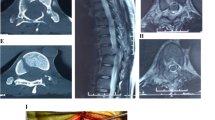Summary
Severe fracture-dislocation of the thoracic spine without neurological deficit is rare. Both translational and rotational deformity of the midthoracic spine makes transection of the cord almost inevitable due to the confined dimensions of the cord and spinal canal. Even though associated fractures of posterior elements are frequently seen, they seldom result in neural sparing. The case of a 24-year-old man who sustained a severe rotational fracture-dislocation of T9/T10 with considerable anterolateral displacement is reported. Due to a fractured left pedicle and a right-sided vertical fracture through the posterior aspect of the vertebral body, alignment of the posterior elements in the spinal canal was maintained and there was no neurological deficit. The patient was operatively treated with posterior segmental instrumentation, and was completely asymptomatic at follow-up 5 years later.
Similar content being viewed by others
References
Abdel-Fattah H, Rizk A (1990) Complete fracture-dislocation of the lower lumbar spine with spontaneous neurologic deompression. Clin Orthop 251: 140–143
Anden U, Lake A, Nordwall A (1980) The role of the anterior longitudinal ligament in Harrington rod fixation of unstable thoracolumbar spinal fractures. Spine 5: 23–25
Böhler L (1943) Die Technik der Knochenbruchbehandlung im Frieden und im Kriege, vol 1, 9th–11th edns. Maudrich, Berlin
Bohlman H (1985) Treatment of fractures and dislocations of the thoracic and lumbar spine. J Bone Joint Surg [Am] 67: 165–169
Bradford D, Akbarnia B, Winter R, Seljeskog E (1977) Surgical stabilization of fracture and fracture dislocations of the thoracic spine. Spine 2: 185–196
Detutoski M, Conlan S, Salciccioli G (1993) Spinal mobility and deformity after Harrington rod stabilization and limited arthrodesis of thoracolumbar fractures. J Bone Joint Surg [Am] 75:168–176
de Lukas JC, Alvarez L, Abril JC, Calvo E (1994) Fracture-dislocation of the thoracic spine without neurological lesion. Injury 25:105–107
Denis F (1983) The three column spine and its significance in the classification of acute thoracolumbar spinal injuries. Spine 8:817–831
Denis F, Burkus J (1992) Shear fracture-dislocations of the thoracic and lumbar spine associated with forceful hyperextension (lumberjack paraplegia). Spine 17:156–161
Gertzbein S, Offierski C (1979) Complete fracture-dislocation of the thoracic spine without spinal cord injury. J Bone Joint Surg [Am] 61: 449–451
Hanley E, Eskay M (1989) Thoracic spine fractures. Orthopedics 12: 689–696
Harms J (1987) Klassifikation der BWS- und LWS-Frakturen. Fortschr Med 105: 545–548
Harryman D (1986) Complete fracture-dislocation of the thoracic spine associated with spontaneous neurologic decompression. Clin Orthop 207: 64–69
Holdsworth F (1970) Fractures, dislocations, and fracture-dislocations of the spine. J Bone Joint Surg [Am] 52: 1534–1551
Jacobs R (1977) Bilateral fracture of the pedicles through the fourth and fifth lumbar vertebrae with anterior displacement of the vertebral bodies. A case report. J Bone Joint Surg [Am] 59: 409–410
Jacobs R, Casey M (1984) Surgical management of thoracolumbar spinal injuries. Clin Orthop 189: 22–35
Korovessis P, Sidiropoulos P, Dimas A (1994) Complete fracture-dislocation of the thoracic spine without neurologic deficit: Case report. J Trauma 36: 122–124
Krallis P, Psicharis P, Dendrinos G (1992) Fracture-luxation du rachis dorsal à grand déplacement sans trouble neurologique: Présentation d'une observation et revue de la littérature. Acta Orthop Belg 58 (1): 84–87
Lewis J, McKibbin B (1974) The treatment of unstable fracture-dislocations of the thoraco-lumbar spine accompanied by paraplegia. J Bone Joint Surg [Br] 56: 603–612
Lindsey R, Dick W (1991) The fixateur interne in the reduction and stabilization of thoracolumbar spine fractures in patients with neurologic deficit. Spine 16: S140–150
London PS (1993) Fracture-dislocations of the spine that may spare the cord: an explanation. Injury 24: 347–349
Magerl F (1987) Klassifizierung der Wirbelsäulenverletzungen. In: Cotta H (ed) Hefte zur Unfallheilkunde, vol 189. Springer, Berlin Heidelberg New York
Magerl F, Aebi M, Gertzbein SD, Harms J, Nazarian S (1994) A comprehensive classification of thoracic and lumbar injuries. Eur Spine J 3: 184–201
McAfee P, Hansen Y, Fredrickson B, Lubicky J (1983) The value of computed tomography in thoracolumbar fractures. J Bone Joint Surg [Am] 65: 461–473
Miyasaka Y, Satomi K, Sugihara S (1993) Posterior fracture-dislocation of the thoracic spine without neurological deficit. A case report and short literature review. Spine 18:2351–2354
Pitman M, Pitman C, Greenberg I (1977) Complete dislocation of the cervical spine without neurological deficit. A case report. J Bone Joint Surg [Am] 59: 134–135
Roaf R (1960) A study of the mechanics of spinal injuries. J Bone Joint Surg [Br] 42: 810–823
Sasson A, Mozes G (1987) Complete fracture-dislocation of the thoracic spine without neurologic deficit. Spine 12: 67–70
Simpson A, Williamson D, Golding S, Houghton G (1990) Thoracic spine translocation without cord injury. J Bone Joint Surg [Br] 72: 80–83
Stauffer E (1984) Internal fixation of fractures of the thoracolumbar spine. J Bone Joint Surg [Am] 66: 1136–1141
Uriarte E, Elguezabal B, Tovio R (1987) Fracture-dislocation of the thoracic spine without neurologic lesion. Clin Orthop 217: 261–265
Vichard Ph, de la Salle R, Tropet Y, Runge M (1983) Fracture-luxation complète D8–D9 sans complications neurologiques. Description lésionelle — déductions thérapeutiques. Rev Chir Orthop 69: 645–648
Weber S, Sutherland G (1986) An unusual rotational fracture-dislocation of the thoracic spine without neurologic sequelae internally fixed with a combined anterior and posterior approach. J Trauma 26: 474–479
Willems M, Braakman R, Van Linge B (1984) Bilateral locked facets in the thoracic spine. Acta Orthop Scand 55: 300–303
Author information
Authors and Affiliations
Rights and permissions
About this article
Cite this article
Liljenqvist, U., Halm, H., Castro, W.H.M. et al. Thoracic fracture-dislocations without spinal cord injury: a case report and literature review. Eur Spine J 4, 252–256 (1995). https://doi.org/10.1007/BF00303421
Received:
Revised:
Accepted:
Issue Date:
DOI: https://doi.org/10.1007/BF00303421




